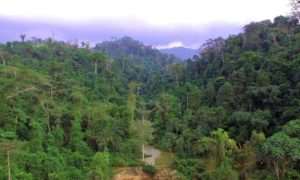
The International Development and Conservation Organisations (IDCO) are calling on the government to remove Kyebi from its plans of mining bauxite and in the Ghana Integrated Bauxite and Aluminum Development Authority Bill currently before Parliament.
The organisations called on President Nana Addo Dankwa Akufo-Addo to reject any plans of splitting the forest into two, for one part to be used for bauxite mining, stating that the water and biodiversity are actually found where the government plans to mine.
They have, therefore, affirmed their readiness and willingness to provide any support that may be useful and appropriate in the achievement of a sustainable development pathway.
The IDCO is made up of WWF International, A Rocha International, Bird Life International, Rainforest Trust, Royal Society for the Protection of Birds, and Global Wildlife Conservation and have a combined membership and support of over 15 million people worldwide.
The Atiwa Forest is on record to be serving over 5 million Ghanaians with their daily water needs. The Densu River, which flows from the Atiwa Forest, feeds the Weija Reservoir, which provides water for close to 2.5 million people in Accra.
A statement, jointly signed by the Chief Executive officers of the six organisations and copied to the Ghana News Agency in Accra on Monday, reiterated the water provisioning significance of the Atiwa Forest.
The statement said the Atiwa Forest is a Key Biodiversity Area (KBA), thus, holds high importance for the global persistence of biodiversity, and harbours rare and threatened species found in few other places in the world.
According to the statement, the IDCO mentioned that apart from the biological importance of the Atiwa Forest, “what is of critical importance is that five million people are dependent on the water provisioning services of the forest.”
It highlighted the concern that bauxite mining in the Atiwa Forest would greatly endanger the large number of species in the forest, which are already globally threatened with extinction.
The statement said over 100 species of birds, mammals, amphibians and plants, and a number of species confined entirely to Atiwa Forest cannot be found elsewhere in the world, adding, “at least, two species are classified by the IUCN with their highest level of extinction threat (Critically Endangered) – the Togo Slippery Frog Conrau aderooi, and the plant Aubregrini ataiensis.”
“Three more species are expected to be classified as Critically Endangered once assessed – the white-naped Mangabey Cercocebus, lunulatus, the Afia Birago Puddle Frog Phrynobatrachus afia birago, and the plant Monanthotaxis atewensis,” it added.
The IDCO in the statement in proposing sustainable development pathways and is convinced that the best use option for Atiwa Forest is ensuring total protection and the promotion of a green economy in the surrounding landscape, but definitely not mining.
The statement again affirmed that a development pathway that seeks to pursue the establishment of a new national park will be widely celebrated, while a conversion and loss of such an important forest will be widely condemned.
There have been calls, campaigns and strong advocacy by several civil society groups in the country and the Concerned Citizens of Atiwa Landscape urging the government to delist Atiwa Forest from targeted areas in the government's planned integrated bauxite development agenda.
This international call comes to support the ongoing advocacy by the non-governmental organisations and the Concerned Citizens of Atiwa Landscape urging the government not to target Atiwa for bauxite mining.
The organisations have indicated that, they are not against the government's agenda to develop and add value to her bauxite resources, but strongly rejects attempts to target the Atiwa Forest, which is also the source of water for over 5 million Ghanaians both upstream and downstream.




 Dumsor: Energy sector ‘shepherdless’ – Nana Amoasi VII
Dumsor: Energy sector ‘shepherdless’ – Nana Amoasi VII
 Train accident: Four more grabbed and remanded
Train accident: Four more grabbed and remanded
 Gov't to consolidate cash waterfall revenue collection accounts
Gov't to consolidate cash waterfall revenue collection accounts
 Gov't to settle lump sum for retired teachers by April 27
Gov't to settle lump sum for retired teachers by April 27
 Former PPA CEO granted GH₵4million bail
Former PPA CEO granted GH₵4million bail
 Dumsor: The darkness has exposed you; you’ll go down as the worst in Ghana’s his...
Dumsor: The darkness has exposed you; you’ll go down as the worst in Ghana’s his...
 Dumsor: The ‘incompetent’ person provided a timetable whiles those who came to s...
Dumsor: The ‘incompetent’ person provided a timetable whiles those who came to s...
 Defend, ensure NPP’s good works are ‘sold’ and highlight the ‘bad’ state of the ...
Defend, ensure NPP’s good works are ‘sold’ and highlight the ‘bad’ state of the ...
 Bawumia will rank high ahead of Mahama in any anti-corruption test — Salam Musta...
Bawumia will rank high ahead of Mahama in any anti-corruption test — Salam Musta...
 NPP trying to bribe us but we‘ll not trade our integrity on the altar of corrupt...
NPP trying to bribe us but we‘ll not trade our integrity on the altar of corrupt...
